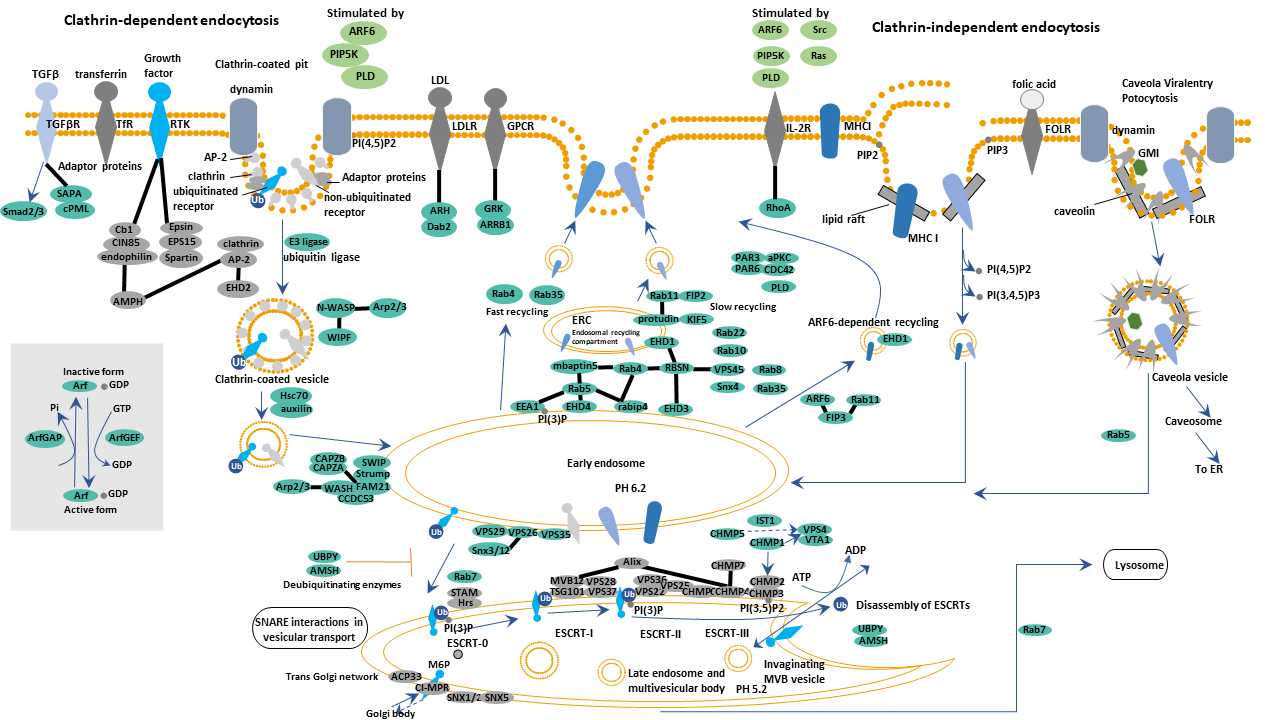
What Is Endocytosis?
Endocytosis is a fundamental cellular process in all eukaryotic cells. It is a process of translocation of extracellular material into cells through vesicles formed by cytoplasmic membrane invagination and wrapping. And the process is energy-consuming.
The Function of Endocytosis
Endocytosis is responsible for the movement of materials from the extracellular milieu into the cytoplasm. Cells regulate their developmental and functional programs through interaction with the external milieu, which requires communication across the plasma membrane. The constant remodeling of the plasma membrane by endocytosis making cells freely respond to external stimuli. And endocytosis also mediates many important cellular processes such as proliferation, migration, and cell division. It is involved in the maintenance of tissue homeostasis such as apical-basal polarity.
The Endocytic Pathways
Endocytosis is usually subdivided into phagocytosis, pinocytosis, and receptor-mediated endocytosis according to the size, material status and specificity of the swallowed molecules.
Phagocytosis
Phagocytosis, also called cellular eating, refers to the process by which cells ingest and internalize large particulates with a diameter of more than 1 μm. Cell partial deformation causes the plasma membrane to invaginate and form pseudopods, which further surround and transport the granules into cells. In the progress, actin participates the prolongation of pseudopodia.
Pinocytosis
Pinocytosis, also known as cellular drinking, is used primarily for the uptake of extracellular fluids, including all solutes present. It usually occurs in the highly ruffled regions of the plasma membrane. The local plasma membrane of the cell sags to form a pit, which surrounds the liquid substances. The small nest leaves the plasma membrane to form a vesicle and enters the cell. The vesicle travels into the cytosol and fuses with other vesicles such as endosomes and lysosomes, to hydrolyze the fluids.
Receptor-mediated endocytosis
Receptor-mediated endocytosis, also named clathrin-mediated endocytosis, is a process by which cells rely on receptors on the cell surface to specifically take in extracellular proteins or other compounds such as metabolites and hormones. These highly specific receptors combine with the endocytosed molecules to form complexes. The part of the plasma membrane where the complexes located is recessed to form inward buds. Extracellular molecules within a vesicle are brought into the cells. The surface of the vesicles is covered with a three-legged protein complex coat, which is assembled by three clathrins and three smaller peptides. The three-legged protein complex provides the mechanical force to pull the plasma membrane, leading to the concave of the capsule. And it also helps to capture the specific receptors on the membrane and the connective transport molecules.
Upon entering the cells, the outer coat of the vesicle is removed and then bound to the small vesicles of the endosome to form a large endosome. The acidic content of the large endosome makes the receptors isolate from the endocytosed molecules. Part of the membrane structure with the receptors sprouts and falls off, and then fuse with the plasma membrane. The receptors return to the plasma membrane and enter the next new recycling.
The Application of Endocytosis
Viral diseases greatly threaten human health. Although there are many anti-viral drugs have been applied in clinical treatment, the frequent mutation of viruses and the emergence of new viruses make them prone to produce drug resistance. Therefore, the development of new antiviral drugs, especially broad-spectrum antiviral drugs that are not easy to produce drug resistance, is particularly important for the treatment of viral diseases.
Clathrin-mediated endocytosis is the main pathway for many viruses and pathogens to enter host cells. So inhibiting the receptor-mediated endocytosis essentially blocks the virus from entering the body. This new antiviral therapy has nothing to do with the virus itself, and it is not easy to develop drug resistance. It has become a potential target of broad-spectrum antiviral drugs in recent years.



